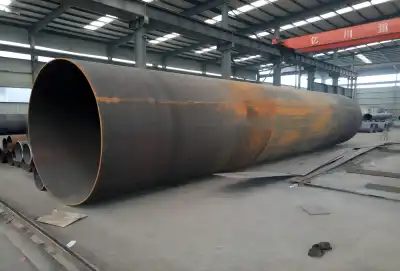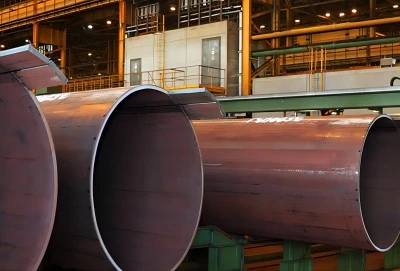Long seam pipes, also known as longitudinally welded pipes, are crucial components in various industries, including oil and gas, construction, and water transportation. These pipes are characterized by a welded seam that runs along their entire length, providing strength and durability for high-pressure applications.
|
|
|
Step-by-Step Manufacturing Process of Long Seam Pipes
The production of long seam pipes involves a series of carefully orchestrated steps, each contributing to the final product's quality and performance. Let's examine these stages in detail:
1. Raw Material Preparation: The process begins with the selection of high-quality steel plates or coils. These materials are carefully inspected for defects and cut to the required dimensions. The thickness and grade of the steel are chosen based on the pipe's intended application and pressure requirements.
2. Edge Preparation: The edges of the steel plates are beveled or shaped to ensure proper fit-up during the welding process. This step is crucial for achieving a strong and uniform weld seam. The edges may be prepared using various methods, including mechanical milling, plasma cutting, or oxy-fuel cutting.
3. Forming: The prepared steel plate is then fed into a forming machine, which gradually bends it into a cylindrical shape. This process can be done using various methods, such as U-O-E forming or JCO (J-C-O) forming, depending on the pipe diameter and wall thickness.
4. Tack Welding: Once the pipe is formed into a cylinder, it is temporarily held together using tack welds. These small welds are placed at intervals along the seam to maintain the pipe's shape and alignment for the main welding process.
5. Inside Welding: The first main welding pass is typically performed on the inside of the pipe. This is done to ensure full penetration and to create a smooth internal surface. Specialized welding equipment is used to access the inside of the pipe and perform this crucial step.
6. Outside Welding: Following the inside weld, the pipe is rotated, and the outside seam is welded. This process completes the full penetration weld and reinforces the pipe's strength. Multiple passes may be required depending on the pipe's wall thickness and material specifications.
7. Non-Destructive Testing (NDT): After welding, the long seam pipe undergoes rigorous testing to ensure the integrity of the weld and the overall pipe structure. Common NDT methods include ultrasonic testing, radiographic testing, and magnetic particle inspection.
8. Heat Treatment: Depending on the material and application requirements, the welded pipe may undergo heat treatment processes such as normalizing, quenching, or tempering. This step helps to relieve internal stresses and improve the pipe's mechanical properties.
9. Hydrostatic Testing: The pipe is subjected to hydrostatic pressure testing to verify its strength and leak-tightness. This involves filling the pipe with water and pressurizing it to a level above its designed operating pressure.
10. Final Inspection and Coating: The pipe undergoes a final visual and dimensional inspection before being coated for corrosion protection. Coatings may include fusion-bonded epoxy (FBE), polyethylene, or other specialized materials depending on the pipe's intended environment.
This meticulous manufacturing process ensures that long seam pipes meet the stringent quality and performance standards required for critical applications in various industries.
Key Welding Techniques Used in Long Seam Pipe Production
The welding process is at the heart of long seam pipe manufacturing, and several advanced techniques are employed to ensure strong, reliable welds. Let's explore some of the primary welding methods used in the industry:
1. Submerged Arc Welding (SAW): This is one of the most common techniques used for long seam pipe production, especially for large-diameter pipes. In SAW, the welding arc is submerged under a layer of granular flux, which protects the weld pool from atmospheric contamination and helps to produce a clean, high-quality weld. The process is highly efficient and can achieve high deposition rates, making it ideal for long seam applications.
2. Electric Resistance Welding (ERW): ERW is typically used for smaller diameter pipes and involves passing an electric current through the edges of the formed pipe. The resistance to this current generates heat, which melts the metal and fuses the seam. This process is fast and efficient, but is generally limited to pipes with thinner walls.
3. High Frequency Welding (HFW): A variation of ERW, HFW uses high-frequency alternating current to heat and weld the pipe seam. This method produces a narrow heat-affected zone and is particularly suitable for pipes requiring high-quality welds with minimal distortion.
4. Laser Welding: Advanced laser welding techniques are increasingly being used in long seam pipe production. Laser welding offers high precision, deep penetration, and minimal heat input, resulting in strong welds with narrow heat-affected zones. This method is particularly beneficial for pipes made from high-strength steels or those requiring precise dimensional control.
5. Hybrid Laser-Arc Welding: This innovative technique combines the benefits of laser welding with traditional arc welding. The laser provides deep penetration and precise heat input, while the arc ensures good gap bridging and adds filler material. This combination results in high-quality welds with excellent mechanical properties.
6. Multi-Wire Submerged Arc Welding: For thick-walled pipes, multi-wire SAW systems are often employed. These systems use multiple welding wires simultaneously, increasing deposition rates and reducing welding time while maintaining high weld quality.
The choice of welding technique depends on various factors, including pipe diameter, wall thickness, material properties, and production volume. Often, a combination of these methods may be used to achieve the desired weld quality and production efficiency.
Materials Commonly Used for Long Seam Pipe Fabrication
The selection of materials for long seam pipe fabrication is crucial to ensure the pipe's performance, durability, and suitability for its intended application. Here are some of the most commonly used materials in the industry:
1. Carbon Steel: This is the most widely used material for long seam pipes due to its strength, versatility, and cost-effectiveness. Different grades of carbon steel are available, ranging from low-carbon to high-strength low-alloy (HSLA) steels. These materials are suitable for a wide range of applications, including oil and gas transmission, water pipelines, and structural uses.
2. Stainless Steel: For applications requiring high corrosion resistance, stainless steel long pipes are often preferred. Various grades of stainless steel are used, including austenitic (e.g., 304, 316), ferritic, and duplex stainless steels. These pipes are commonly used in chemical processing, food and beverage industries, and marine environments.
3. Alloy Steels: Specialized alloy steels are used for long seam pipes that need to withstand extreme temperatures, high pressures, or corrosive environments. Examples include chrome-moly steels (e.g., P11, P22) for high-temperature applications and nickel alloy steels for sour service in the oil and gas industry.
4. API Grade Steels: The American Petroleum Institute (API) specifies various grades of steel for oil and gas pipeline applications. Common grades include API 5L X42, X52, X65, and X70, each offering different levels of strength and toughness to meet specific operational requirements.
5. Clad Pipes: In some cases, long seam pipes are manufactured using a combination of materials. Clad pipes consist of a base material (usually carbon steel) with an inner layer of corrosion-resistant alloy (such as stainless steel or nickel alloy). This combination provides the strength of steel with enhanced corrosion resistance.
6. High-Strength Steels: For deep-water offshore applications or high-pressure onshore pipelines, ultra-high-strength steels are used. These materials, such as X80, X100, or even X120 grade steels, offer exceptional strength-to-weight ratios and allow for thinner wall pipes that can withstand extreme pressures.
The choice of material for long seam pipe fabrication depends on various factors, including operating pressure, temperature, corrosive conditions, and regulatory requirements. Engineers and metallurgists work closely to select the most appropriate material that balances performance, longevity, and cost-effectiveness for each specific application.
Contact Longma Group
For those seeking high-quality long seam pipes for their projects, it's essential to partner with experienced manufacturers who have a proven track record in producing pipes that meet or exceed industry standards. Longma Group, as one of China's leading ERW/LSAW steel pipe manufacturers since 2003, specializes in the production of large-diameter, thick-walled, double-sided, sub-arc-seam welding steel pipes. With an annual output exceeding 1,000,000 tons by the end of 2023, Longma Group has established itself as a reliable partner for LSAW (Longitudinal Submerged Arc Welded) and ERW steel pipes. For more information or to discuss your specific pipe requirements, please don't hesitate to contact Longma Group at info@longma-group.com.














